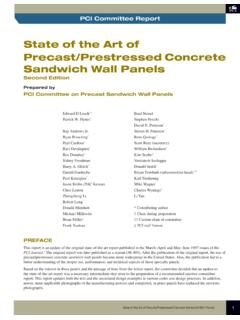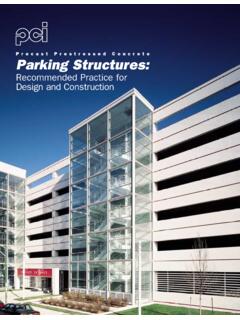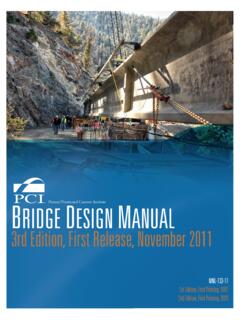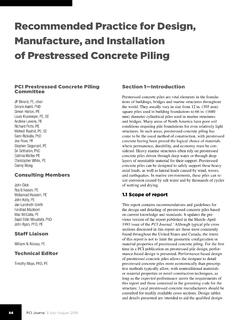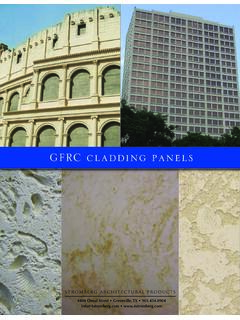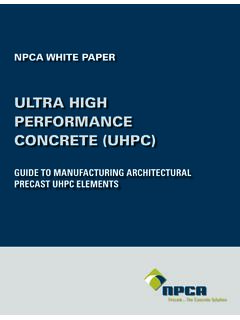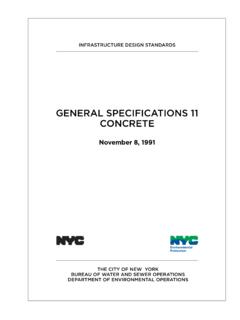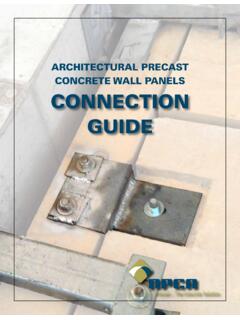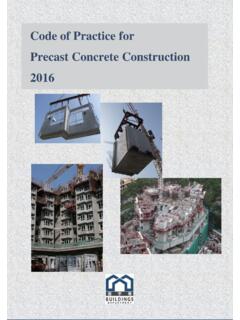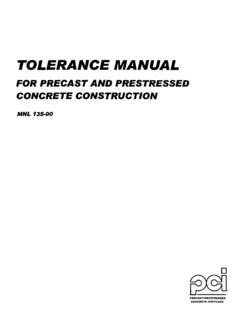Transcription of ARCHITECTURAL PRECAST CONCRETE JOINT DETAILS
1 ARCHITECTURAL PRECAST . CONCRETE JOINT DETAILS . Reported by PCI Committee on ARCHITECTURAL PRECAST CONCRETE JOINT DETAILS Raymond J. Schutz Chairman James Engle Albert Litvin James G. Gross R. L. Pare Abraham Gutman John S. Parrish J. A. Hanson Irwin J. Speyer Kai Holbek Ivan L. Varkay Felix Kulka Lloyd Wright Correct JOINT design and proper selection of materials and installation are vital for the successful performance and esthetic appeal of PRECAST CONCRETE wall systems. This report recommends the proper PRECAST CONCRETE JOINT DETAILS and sealants for specific situations. In writing these recommendations, ARCHITECTURAL treatment and economy in mold design were considered but are not included, since these are covered in the PCI Manual on ARCHITECTURAL PRECAST CONCRETE . Following these recommendations will result in a good design and a durable, waterproof, and economical JOINT . 10. CONTENTS. Chapter1 JOINT design .. 12. Scope Types of joints General design concepts for joints Number of joints Location of joints Chapter 2 Planning check lists.
2 14. Definitions JOINT planning Water runoff planning Chapter3 JOINT DETAILS .. 15. General One-stage joints Two-stage joints Cavity wall Floor and roof slab joints PRECAST parapets PRECAST panel window DETAILS Chapter 4 Sealant materials .. 24. General Field-molded sealants and their uses Accessory materials Preformed sealants and their uses Compression seals and their uses JOINT design Determination of JOINT movements and locations Selection of butt JOINT widths for field-molded sealants Selection of butt JOINT shape for field-molded sealants Selection of size of compression seals for butt joints Limitations on butt JOINT widths and movements for various types of sealants Lap JOINT sealant thickness References .. 36. PCI Journal/March-April 1973 11. CHAPTER 1 JOINT DESIGN. Scope that it generally provides the lowest first cost, and it is suitable for use be- The design of joints must be exe- tween PRECAST panels as shown in Figs. cuted as an integral part of the total to wall design.
3 Some specific guidelines The success of one-stage joints de- for joints do govern their ultimate suc- pends on the quality of materials and cess. This chapter highlights and illus- proper installation at the building site. trates several cases of interdependence This type of JOINT is in common use in with other wall design criteria. most of North America. One-stage In all cases, the designer should as- joints should be regularly inspected and sess his requirements for joints realisti- may demand fairly frequent mainte- cally with respect to both performance nance to remain weathertight. and cost. If JOINT designs and DETAILS are contemplated which differ from those Two -stage joints. These joints normally used in the area where the have two lines of defense for weather- project is located, local producers proofing. The typical JOINT consists of a should be consulted. rain barrier near the exterior face and an air seal normally close to the interior The following discussion will deal face of the panels .
4 The rain barrier is mainly with joints which are designed designed to shed most of the water to accommodate local wall movements from the JOINT and the air seal is the de- only, rather than an accumulation of marcation line between outside and in- such movements which would require side air pressures. Between these two properly designed expansion joints. stages is an equalization or expansion chamber which must be vented and drained to the outside. Section gives Types of joints typical DETAILS of two-stage joints. It can be seen that the simplest form of a hor- Joints between PRECAST wall panels izontal two-stage JOINT is the well prov- may be divided into two basic types: en shiplap JOINT . 1. One-stage joints The rain barrier prevents most of the 2. Two-stage joints rain and airborne water from entering A cavity wall design is considered a the JOINT . If airborne water (wind-driv- further application of the two-stage en rain) penetrates this barrier, it will JOINT .
5 Drain off in the expansion chamber as the kinetic energy is dissipated and the One-stage joints. As the name air loses its ability to carry the water. implies, this JOINT has one line of de- Any water which penetrates the rain fense for its weatherproofing ability. barrier should be drained out of the This occurs normally in the form of a JOINT by proper flashing installations. sealant close to the exterior surface. In order to avoid vertical movement The advantage of this type of JOINT is of the air in the expansion chamber 12. (stack effect) caused by wind or outside The two-stage JOINT is gaining accep- air turbulences, it is advisable to use tance particularly for buildings subject these flashing DETAILS as dampers and to severe climatic exposure or tempera- provide them at regularly spaced inter- ture and humidity control. vals along the height of the vertical A disadvantage of the two-stage JOINT joints. Such flashing is sometimes in- for CONCRETE wall panels is the higher stalled at each floor level, but a greater cost.
6 For projects with good repetitive spacing (two or three stories) may be JOINT design properly integrated with sufficient for low-rise buildings and in other panel DETAILS , and having efficient areas with moderate wind velocities. production and erection procedures, it Since the air seal is the plane where may well approach the cost of one-stage the change in air pressures between the JOINT installations. In these instances, outside and inside atmospheres occurs, the safety factors and lower mainte- it would normally be subject to water nance costs should also be considered. penetration through capillary action. A minimum PRECAST wall panel thick- Inasmuch as the outside air reaching ness of 4 in. ( cm) (with field- this seal has lost its water content, no molded sealants), preferably 5 in. ( moisture can enter by such action. cm) (with gaskets and compression The danger of humidity traveling seals), is required to accommodate both from inside the building and through the rain barrier and the air seal.
7 For the air seal should be investigated for two-stage joints with compression seals, buildings with relatively higher interior connection detail allowance should be humidity, and for tall buildings, where made for slight horizontal movements the interior air pressure may occasion- of the panels after initial fastening for ally be substantially higher than the air seal The joints must outside atmospheric pressure. This con- be fully accessible from the inside of dition is normally solved by using a the panels for later installation of the cavity wall design. air seal. The simplest form of a horizon- A cavity wall (Fig. ) is the most tal two-stage JOINT is the shiplap JOINT . effective wall for the optimum separa- tion and control of both outside and in- side air and humidity conditions. When General design concepts PRECAST CONCRETE wall panels are used in for joints cavity wall designs, they will normally serve as the rain barrier. An air space is The purpose of JOINT design is to pro- maintained between the PRECAST exteri- vide weathertightness of the JOINT con- or and the interior wall.
8 Insulation, sistent with the exposure of the JOINT . In when required, is applied to the outside addition, as part of the overall perfor- face of the interior wall, eliminating mance requirements of the building, condensation problems and, thereby, the purpose for which the building is making the inner wall subject only to built will also determine design require- the relatively constant interior tempera- ments for the JOINT . ture. Cavity wall construction is nor- Thus, JOINT design will be governed mally expensive when compared with by its exposure (orientation and climatic conventional walls. On the basis of their conditions), the purpose of the building, lower maintenance costs and their ex- and appearance. The following guide- cellent performance records, they may lines must all be evaluated in relation well be justified for specific types and to the relative importance of these cri- locations of buildings. teria. PCI Journal/March-April 1973 13.
9 Number of joints manufactured and erected to close tol- erances. Hence, it is recommended that It is generally advantageous to plan joints be placed in any ribbed projec- for the fewest number of joints, due to tions of panels . the lower overall JOINT cost, potentially lower maintenance cost, and the econ- If ribs are too narrow to accommo- omy of large panel erection. date joints, the full rib may be located in one panel only (Fig. ). Another Optimum panel sizes must, however, solution is to design every second panel also be determined from erection condi- with ribs at both edges using the bal- tions and established limitations of ance as infill units. weight and sizes for An important factor in locating and If the desired appearance requires detailing joints is a proper assessment additional joints, this may be achieved of the predicted weathering pattern for through the use of false or dummy the structure. To limit weathering ef- joints.
10 In order to match the appear- fects on the building, it is advisable to ance of both false and real joints, an emphasize the joints by making them applied finish should be chosen to sim- wide and recessed from immediately ulate sealants or gaskets in the real adjacent surfaces. 8 Joints in forward joints. Caulking of the false joints adds sloping surfaces are difficult to weather- an unnecessary expense. proof, especially where they may col- lect snow or ice. When these surfaces Location of joints cannot be avoided, the architect should include a second line of defense against Joints are easier to design and exe- water penetration. This may be cute if they are located where maxi- mum panel thickness occurs. Except for achieved by sealing the front of the sur- one-stage joints and joints in PRECAST face and using a two-stage JOINT . If a panels performing as rain barriers in one-stage JOINT is used, the owner must cavity walls, the minimum panel thick- accept regular inspection of such joints ness at joints should be 4 in.

